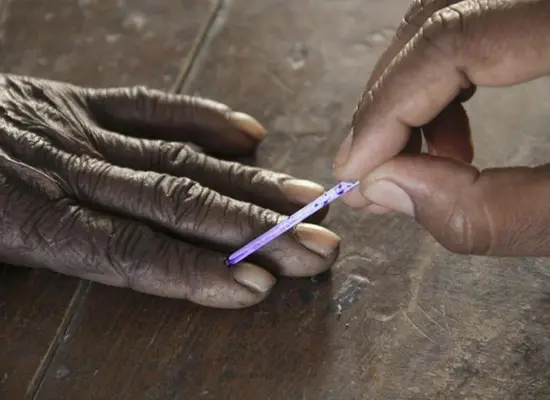The first two of the seven phases of elections in Uttar Pradesh are expected to set the tone. While it's a do- or- die for the Samajwadi Party, stakes could not have been higher for the BJP. The UP polls will also test the popularity of the BJP and the Prime Minister, Narendra Modi after he announced the repeal of the contentious farm laws. If BJP wins UP it would not only put the party in an invincible position but would decimate whatever Opposition remains at this juncture. But if the results go against the party, it could have a major impact and reignite the entire Opposition. For BJP, the first two phases (February 10 and 14) are going to be the most challenging as these would cover the regions hit by 13 month-long farmers' agitation.
Now, with nearly a week to go for the crucial first phase of highly charged Uttar Pradesh elections, Prime Minister Narendra Modi is set to make another foray in western Uttar Pradesh, where the going continues to get tough for the BJP. All eyes are on Prime Minister Narendra Modi's pitch to woo the voters by holding a virtual rally in Aligarh, Noida, Meerut, Ghaziabad and Hapur on Friday. His virtual outreach would cover 23 Assembly constituencies.
Samajwadi Party president, Akhilesh Yadav has gone on record saying that the "first phase of the UP elections is a farmers' election and will set the tone for the remaining phases." Aware that the first two phases would set the momentum, the BJP had been relentlessly para dropping the saffron heavyweights in this region.
Also read: BJP begins carpet bombing in western UP
While the SP-RLD alliance is trying to combine the Jats and Muslims against the BJP, the saffron brigade has been trying to woo the Jat community with its Hindutva push. As a BJP leader puts it-"In western UP, the fight is between SP's OBC outreach and BJP's Hindutva push."
Jats comprise around 17 per cent in western UP and have significant influence in nearly 40 Assembly seats and over 10 Lok Sabha berths. In the first phase, 58 seats in Jat dominated Muzaffarnagar, Meerut, Ghaziabad, Shamli, Hapur, Baghpat, Gautam Budh Nagar, Bulandshahr, Aligarh, Mathura and Agra would go to polls.
A strong polarisation following the 2013 Muzaffarnagar riots finally snapped the Jat-Muslim bonding, stitched by the "tallest" Jat leader and former Prime Minister Chaudhury Charan Singh.
The polarisation helped the BJP in the 2014 Lok Sabha polls when the Modi wave swept away the opponents. In 2017, the BJP once again repeated its stellar performance by winning 73 of the 94 seats in the 17 districts of western UP. In 2017, the BJP had fielded 15 Jat candidates of which 14 won. This time the party has fielded 17 Jat candidates. Besides the Jats, a majority of the OBC community including Maurya, Saini, Kushwaha and Shakya rallied around BJP in the 2017 assembly and 2019 Lok Sabha polls. However, the recent exodus of influential OBC leaders has delivered a body blow to the party.
If reports and political posturings are to be believed, the Bharatiya Kisan Union leader, Rakesh Tikait, one of the most prominent faces of the farmers' protest against the now-repealed contentious farm laws has rebuffed BJP's attempts to woo him. Speaking to an online news portal, Tikait has dismissed reports that BKU has "softened" its stance against the BJP following the meeting between Union Minister, Sanjay Balyan and his elder brother, Naresh Tikait. He further claimed that BJP's effort to polarise the vote bank by using the "Kairana model will not work this time." Recently Home Minister, Amit Shah visited families believed to have been affected by the alleged exodus of the Hindus from the area during the communal violence. The Home Minister maintained that the return of the affected families was possible due to the improved law and order situation under the Yogi Adityanath rule.
If BJP has put in motion its Hindutva juggernaut, the SP was hoping to get back the formidable combination of 17 per cent Jats and 26 per cent Muslims back on the track following its alliance with the RLD. However, in 2017 while SP won 15 seats, RLD managed only one seat in the region. Also, over the last two decades, RLD seemed to have weakened significantly in the region.
Following BSP leader, Mayawati's social engineering, a huge chunk of the RLD vote had earlier shifted to her kitty. In 2014, the Jat votes began gravitating towards the BJP.
Some of the BJP spin doctors observed that the SP-RLD alliance "just might work in their favour." This school of thought argued that while the "SP's Muslim vote will move to RLD, the Jat votes might not shift to SP's Muslim candidates." For these BJP leaders, the Jat votes would "split between BJP and RLD." However, the socialists claim that the western UP "is all set to witness the return of the MAJGAR alliances (Muslim, Ahir, Jat, Gujjar and Rajput including farmers) formed by Chaudhury Charan Singh."
Also Read: Why did Congress veteran RPN Singh quit the party and join BJP?




















